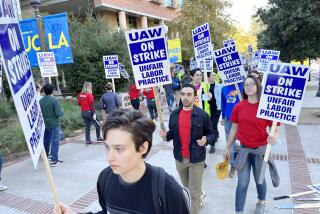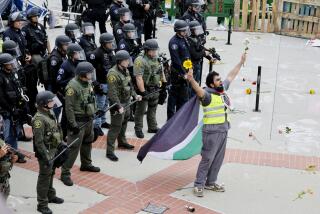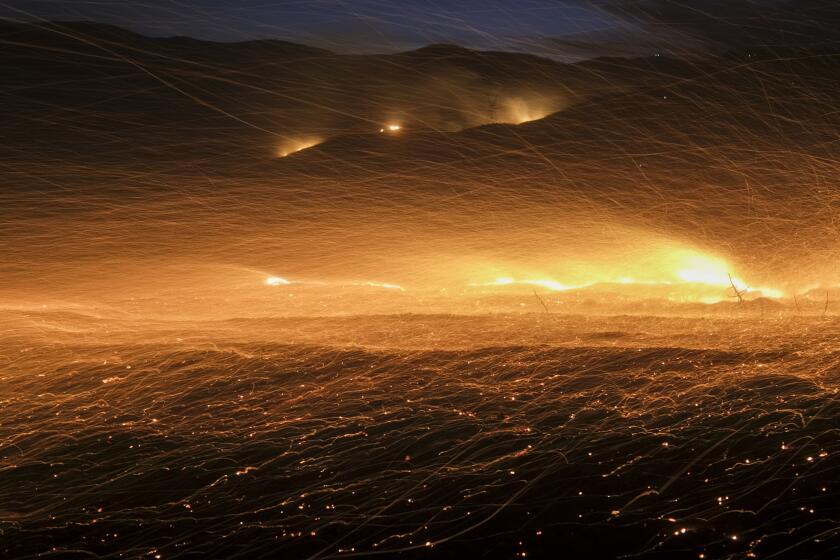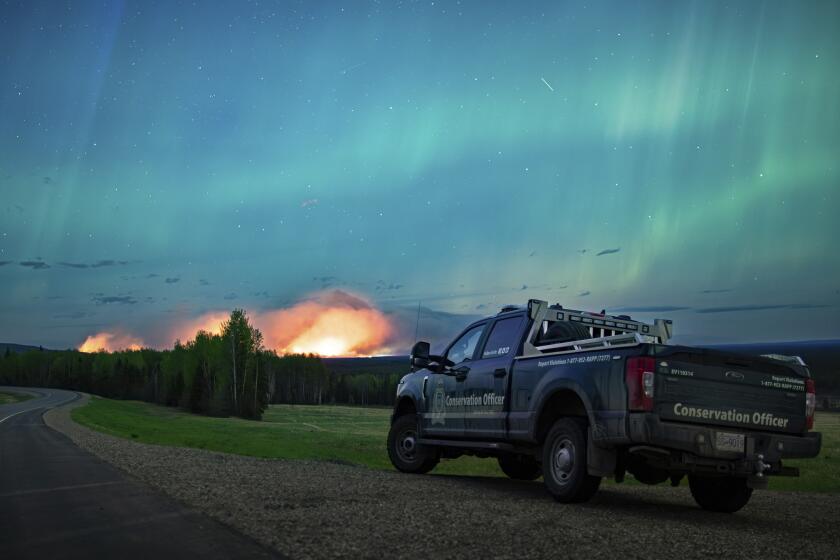Days of Tension : Firefighters Wait for Call to Inferno
A lot of what a firefighter does is wait, even in brush-fire season.
It’s only July, but this year already looks like the worst for brush fires in recent memory. The TV news footage being watched by about a dozen firefighters at Station 125 of the Los Angeles County Fire Department showed dozens of their sweltering colleagues on a hillside, facing flames covering thousands of acres in Ventura County. A shift in plans could quickly make the watchers the watched.
But for these watchers in Station 125 in Calabasas, there was merely the waiting, and with it a conflict that many said they experience, between impatience for action and their memory of just how grueling action can be. Said one: “When I’m here I want to be there, and when I’m there I want to be here.”
“This is no different than a battlefield,” Capt. John Dishaw said Thursday as he leaned against a fire engine in the station at Las Virgenes Road and the Ventura Freeway. “I have known firemen who have been in ‘Nam or Korea, and they’ve told me how a lot of those guys actually saw battle only a little of the time. There was a lot of waiting around.”
Like a Barracks
Actually, Station 125 this week was more like a barracks set back from the battlefields that absorbed most of the county Fire Department’s attention. First, starting Sunday, came the fire near Lake Sherwood, which burned for three days and kept some of the men at Station 125 away from their homes for all three. Then, starting Monday, was the massive fire in the Ojai Valley, where many Los Angeles fire units were helping out.
Fire departments pool their efforts in such times. They form strike teams of several fire engines, each carrying three or four firefighters. The decisions as to where they will go are being made in a converted warehouse in Riverside where representatives of nine local, state and federal firefighting agencies have gathered.
At that nerve center, the task is to determine how to fight one fire without leaving another area unguarded. Formally, the converted warehouse is called the Multi-Agency Command Center. Informally, it’s called the “war room.”
Station 125 plays an important part in the maneuvers in the regional war on fire, fire officials said. Because of its strategic location by the freeway, it mostly has been used lately as a place where fire companies from around the county meet to form the strike teams before moving on.
Station With Room
Unlike many stations in neighborhoods, Station 125 has considerable room in front, which can be used to park many fire vehicles. Parked outside almost continuously this week were several red cars of battalion chiefs and the low-bed trucks that carry the giant bulldozers fire departments use to plow under burning brush.
At one time Wednesday, a red line of more than 10 fire engines stretched in front of the station house.
On that day, more than 25 men with two five-engine strike teams were summoned to Station 125. All day at the big, gray building, which has a broad, peaked roof, blue-uniformed men came and went, their motions ordered by the voices of commanders unseen on the other end of telephones and two-way radios.
Nobody went directly to a fire from Station 125. Instead, they got orders to go to other firehouses, and, perhaps, on from there.
‘I Love My Job’
“God, the time sure can go slowly,” said Steve Sanders, a dark-haired, 25-year-old firefighter. But Sanders, whose father is a firefighter and who said there is nothing else he ever wanted to be, wasn’t complaining. “I love my job,” he said. “The waiting? That’s just part of it.”
Wednesday evening, the two strike forces were dispatched to a station in Westlake Village. After eating dinner there, they got orders to move on to the Ojai Valley.
The northward migration of men and equipment left fire officials concerned about the thin resources left behind. Five county firefighters permanently based at Station 125 eventually were moved to another station in Ventura County to cover for another group that had been sent up to Ojai.
The day was a welcome respite for the five: Capt. Frank Coley, and firefighters Tom Ford, Larry Allomong, Bill Bennett and Pete Andruska. They had fought the Lake Sherwood fire, missing at least one night’s sleep. So they were ready to take it easy on the 24-hour shift they started at 8 a.m. Wednesday by watching some TV and taking their time over a lunch of rolls and cold cuts.
‘Drier Than Usual’
Typically, the overnight shift--standard for county firefighters--means sleeping at the station, which has eight beds. But the five men would end up spending the night at another station.
The firefighters who operate out of Station 125 mainly handle brush fires on the hills and ridges in the area. “I’m more anxious this year because it’s a lot drier than usual,” said Allomong.
His group is part of about 25 men who rotate shifts at Station 125. They have known each other for years. “You hang around the station house together, you play cards, you eat together and you get to know that you can depend on each other when you have to,” said Allomong, 34.
Every station house has its own customs and its own legends. For example, one of about 30 card games the five men know is “no-spleen dean.”
No-spleen dean is a poker game named for a retired fire captain who once was shot with a .357 Magnum. He survived, but his spleen was removed.
Threes, Fives, Sevens Wild
The game is played with threes, fives and sevens wild, in honor of the weapon used. Each player must take two new cards twice, reflecting the number of times the firefighter was shot.
The card games become more intense after the firefighters have eaten at the broad table in the station’s kitchen. The prize for losing is washing the dishes. Firefighter Tom Ford almost always loses. After lunch, the other four cleared out of the kitchen, and Ford stayed on alone.
Bent over the kitchen sink, he spoke about the domestic problems that can result from long hours in a firehouse and fighting fires. “Divorce is an occupational hazard,” he said. “I’ve been married three times,” Ford said. “The one I’m married to now has walked out on me six times because she couldn’t stand the loneliness, but we’ve been married 11 years, so I think it’s going to be successful.”
At about 2 p.m., Steven Oldaker and and Michael Perkins came back from the front lines of the still-smoldering Lake Sherwood fire. The two are part of a three-man crew assigned to transport and operate the bulldozers that, along with helicopters and chemical-laden planes, are mobilized to fight large brush fires.
Grimy and exhausted after being on duty almost steadily since the fire began, the two showed up at Station 125 to wash up and take a rest. “The ‘dozer job is extremely hazardous,” said Perkins, 38, who said he has been with the department for 13 years. “Any time you go on a hot, moving fire you’re in danger of being overrun.”
Perkins, a narrow-faced man with a severe expression, said he had hoped to be relieved that afternoon and go home. “I want to go home at 6 p.m., I want to go home,” he said. “But I can feel it in my bones that it’s not going to happen.”
Long Drive North
He was right. Within a couple of hours he was dispatched on the long drive to Santa Barbara to help battle the rapidly spreading fire in the Ojai Valley, which had become several fires. Clearly not happy about it, he climbed behind the steering wheel of the rig that hauls the bulldozer, and roared off.
At about the time the men were returning from the Lake Sherwood fire, two strike forces started forming at Station 125. The men came from Huntington Park, downtown Los Angeles, South Gate and other towns and filled the leisure room to watch a TV news update on the aftermath of Tuesday’s fire in Baldwin Hills that killed three people and destroyed numerous homes.
The room fell quiet. Some shook their heads at the sight of a hospitalized old man, his hands burned and bandaged. “There’s so much heat,” the old man said, his voice shaking. “You’re walking down the street and there’s fire on both sides. It’s so hot. My injuries are from heat, not flames.”
In unison, several of the men nodded as the old man spoke.
Concern About Structures
“The thing you worry about most, of course, is structures,” Firefighter Tom Ford said. “Where you have fires getting to peoples’ homes, you start having a situation where people’s lives are at stake.
“I’ve had people die right in my hands,” he said, holding those hands out in front of his face.
At 5 p.m., a phone call came and the men with the two strike forces climbed onto their trucks, drove off and went to wait somewhere else. Capt. Frank Coley and two of the four men under him also boarded their engine, No. 125, and drove away.
The station house was empty except for a paramedic truck with first-aid equipment and medicine. Two of Coley’s men who double as paramedics, Bennett and Andruska, stayed behind to continue their wait.
About half an hour later a call came and the two men dashed to the vehicle. As he was about to close the door, Andruska was asked if he was heading to a fire.
“Nope,” he said, as he slammed the door and turned on the siren. “Someone’s having chest pains.”
More to Read
Start your day right
Sign up for Essential California for news, features and recommendations from the L.A. Times and beyond in your inbox six days a week.
You may occasionally receive promotional content from the Los Angeles Times.






